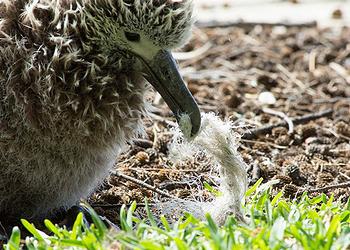
MONTEREY, California, July 10, 2017 (ENS) – Stopping the flow of plastic pollution into oceans and lakes is the goal of a new partnership of 19 U.S. aquariums that say plastic waste is one of the gravest threats facing ocean and freshwater animals.
Aquariums from coast to coast are shifting away from single-use plastic products and packaging, and they will try to persuade consumers to build market demand for innovative alternatives to these plastics.

“The public trusts aquariums to do what’s right for the health of the ocean and for ocean wildlife,” said Julie Packard, executive director of the Monterey Bay Aquarium, a founding member of the new Aquarium Conservation Partnership, ACP.
“We’re just beginning to understand the full impacts of ocean plastic pollution on ecosystems, marine life and human health,” said Packard. “But we already know enough to say that now is the time to act.”
Through the national “In Our Hands” campaign, the ACP hopes to empower their 20 million visitors and millions more in their communities to drive a national shift away from single-use plastic and toward innovative alternatives.
All 19 aquariums are themselves moving away from single-use plastics. As of today, all ACP members have eliminated plastic straws and single-use plastic take-away bags from their premises.
The campaign includes a website aimed at inspiring visitors to make positive everyday behavior changes and raise awareness of the plastics issue.
The aquariums have committed to greatly reduce or eliminate plastic beverage bottles by December 2020 and showcase innovative alternatives to single-use plastic at their facilities.

“As leaders in aquatic conservation, aquariums are expected to walk their talk, and that’s exactly what this partnership is meant to do,” said National Aquarium CEO John Racanelli.
“We are uniquely qualified to set an example for others,” said Racanelli, “in reducing our plastic footprint, encouraging sustainable operating practices, and inspiring hope in a public that is hungry to be part of the solution. We’re right where we should be.”
About 8.8 million tons of plastic enters the ocean each year worldwide – roughly a dump truck full of plastic every minute of every day.
In the United States alone, plastic waste averages more than 200 pounds per person each year. If nothing changes, by 2025 the flow of plastic into the ocean is expected to double.
Plastic pollution in lakes and rivers has been found at levels as high, or higher, than in oceanic gyres that concentrate plastic trash.
Today, there are an estimated one billion plastic particles floating on the surface of Lake Michigan alone.

The Great Lakes are the largest surface freshwater system on the Earth, making up approximately 21 percent of the world’s supply of surface freshwater. Additionally, more than 3,500 species of plants and animals live in the Great Lakes basin.
Shedd Aquarium President and CEO Dr. Bridget Coughlin said, “Approximately 22 million pounds of plastic flows into the Great Lakes each year – in Lake Michigan alone, it is equivalent to 100 Olympic-sized swimming pools filled with bottles.”
“Small actions can turn into big solutions, and we believe the 24 million people in the United States who rely on this beautiful, massive resource for their drinking water, jobs and livelihoods want to be part of that wave of change,” said Coughlin. “We look forward to working together in these commitments.”
The Aquarium Conservation Partnership was first championed by the Monterey Bay Aquarium in California, National Aquarium in Baltimore and Shedd Aquarium in Chicago, in collaboration with the Association of Zoos and Aquariums. Coalition partners are located in 16 states and include:
• California: Aquarium of the Pacific in Long Beach; California Academy of Sciences/Steinhart Aquarium in San Francisco; and Monterey Bay Aquarium
• Connecticut: Mystic Aquarium in Connecticut
• Florida: The Florida Aquarium in Tampa
• Illinois: Shedd Aquarium in Chicago
• Kentucky: Newport Aquarium in Kentucky
• Louisiana: Audubon Nature Institute/Aquarium of the Americas in New Orleans
• Maryland: National Aquarium
• Massachusetts: New England Aquarium in Boston
• Nebraska: Omaha’s Henry Doorly Zoo and Aquarium in Nebraska
• New York: Wildlife Conservation Society/New York Aquarium in New York City
• North Carolina: North Carolina Aquariums
• South Carolina: South Carolina Aquarium in Charleston
• Tennessee: Tennessee Aquarium in Chattanooga
• Texas: Texas State Aquarium in Corpus Christi
• Virginia: Virginia Aquarium in Virginia Beach; and
• Washington: Point Defiance Zoo and Aquarium in Tacoma; and Seattle Aquarium

This summer, the aquariums will focus on raising awareness and sparking consumer action, and sharing their own success stories to highlight the many ways they’ve cut back on single-use plastic in their operations.
They are working with business partners to showcase innovative alternatives to single-use plastic products, and will collaborate with vendors to accelerate design of new products and materials.
They are also finding ways to use less plastic packaging in gift store items, and scaling back on single-use plastic in their cafes and restaurants.
The aquariums are also using their collective voice at the local, state and national levels to support policies that reduce the flow of plastic pollution into the ocean, rivers and lakes. Beyond sponsoring clean-up events and education programs, many have backed successful efforts to stem the use of plastic shopping bags and plastic microbeads found in personal care products.
“By using our voice with visitors and in our communities, our collective buying power and our relationships with our vendors, we can make a big difference on a pressing issue that threatens the health of wildlife in the ocean, lakes and rivers,” said Packard. “The solution to plastic pollution is in our hands.”
Copyright Environment News Service (ENS) 2017. All rights reserved.
© 2017, Environment News Service. All rights reserved. Content may be quoted only with proper attribution and a direct link to the original article. Full reproduction is prohibited.
